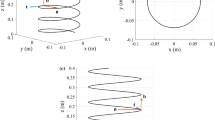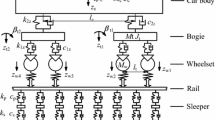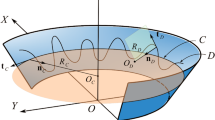Abstract
A novel approach to velodrome track design is presented. The mathematical model uses differential geometry to form a three-dimensional ruled surface. The surface accounts for the safety zone, blue band, and track region, the latter of which is comprised of three segments: straight lines, the arcs of circles, and connecting transition curves. Following a first-principles approach, the general expressions are derived from the Frenet–Serret relations, as a function of the banking and curvature profiles, lengths of curve segments, and turn radius of the bends. Particular solutions to the design problem are obtained using a least-squares minimization of an objective function, within the framework of numerical optimization. Symmetric and asymmetric designs are presented to demonstrate the versatility of the approach. The resulting formulation may be used to design velodrome tracks of any UCI Category and track geometry specification.






Similar content being viewed by others
Data availability
Not applicable.
Code availability
Not applicable.
Notes
We detail the pertinent regulations that restrict the velodrome surface design; the complete list of technical specifications are listed in [17, Chapter VI].
For instance, although we do not consider such features in this article, the banking profile could be designed to have portions with constant inclination angle.
References
Olds T, Norton KI, Lowe ELA, Olive S, Reay F, Ly S (1995) Modelling road-cycling performance. J Appl Physiol 78(4):1596–1611
Martin JC, Milliken DL, Cobb JE, McFadden KL, Coggan AR (1998) Validation of a mathematical model for road cycling power. J Appl Biomech 14(3):276–291
Martin JC, Gardner AS, Barras M, Martin DT (2006) Modelling sprint cycling using field-derived parameters and forward integration. Med Sci Sports Exerc 38(3):592–597
Lukes R, Carré M, Haake S (2006) Track cycling: an analytical model. Eng Sport 6:115–120
Underwood L, Jermy M (2010) Mathematical model of track cycling: the individual pursuit. Procedia Eng 2(2):3217–3222
Underwood L, Jermy M (2014) Determining optimal pacing strategy for the track cycling individual pursuit event with a fixed energy mathematical model. Sports Eng 17:183–196
Caddy O, Fitton W, Symons D, Purnell A, Gordon D (2017) The effects of forward rotation of posture on computer-simulated 4-km track cycling: Implications of Union Cycliste Internationale rule 1.3.013. Proc Inst Mech Eng Part P J Sports Eng Technol 231(1):3–13
Cheng J, Du X, Shi J, Zhang Y, Li F (2011) Optimization of superelevation runoff model for cycling tracks. J Central South Univ 18:587–592
Woźniak M, Anioł P (2011) Inventorying the shape of a velodrome track by scanning. Rep Geodesy z.1/90:525–530
Fitton B, Symons D (2018) A mathematical model for simulated cycling: applied to track cycling. Sports Eng 21:409–418
Benham GP, Cohen C, Brunet E, Clanet C (2020) Brachistochrone on a velodrome. Proc R Soc A Math Phys Eng Sci 476:20200153
Lukes R, Hart J, Haake S (2012) An analytical model for track cycling. Proce Inst Mech Eng Part P J Sports Eng Technol 226(2):143–151
Solarczyk MT (2020) Geometry of cycling track. Budownictwo i Architektura 19(2):111–119
Fitzgerald S, Kelso R, Grimshaw P, Warr A (2021) Impact of transition design on the accuracy of velodrome models. Sports Eng 24(23)
Bos L, Slawinski MA, Slawinski R, Stanoev T (2022) Modelling of cyclist’s power for timetrials on a velodrome. arXiv arXiv:2201.06788 [physics.class-ph]
Frigg R, Hartmann S (2020) Models in science. In: Zalta EN (ed) The stanford encyclopedia of philosophy, Spring 2020 edn. Metaphysics Research Lab, Stanford University, USA. https://plato.stanford.edu/archives/spr2020/entries/models-science/
UCI (2021) Union Cycliste Internationale Regulations. Part III: track races. www.uci.org/inside-uci/constitutions-regulations/regulations. Accessed 2021
Gray A, Abbena E, Salamon S (2006) Modern differential geometry of curves and surfaces with mathematica. Textbooks in mathematics, 3rd edn. CRC Press, Boca Raton
Kreyszig E (1991) Differential geometry, reprint. Originally published: Toronto: Univeristy of Toronto Press, 1959 (Mathematical expositions; no. 11) edn. Dover Books on Mathematics. Dover Publications, Inc., New York
Spivak, M. (1979) A comprehensive introduction to differential geometry. A comprehensive introduction to differential geometry. 2nd edn. vol 2. Publish or Perish, Inc., Lombard
Magnus W (1954) On the exponential solution of differential equations for a linear operator. Commun Pure Appl Math 7(4):649–673
Powell MJD (1981) Approximation theory and methods. Cambridge University Press, Cambridge
Bloss AE (1936) Der Übergangsbogen mit geschwungener Überhöhungsrampe. Organ für die Fortschritte des Eisenbahnwesens 73(15):319–320
Kufver, B (1997) Mathematical description of railway alignments and some preliminary comparative studies. VTI rapport, vol 420, part 1. Swedish National Road and Transportation Research Institute
Watorek K (1907) Übergangsbogen. Organ für die Fortschritte des Eisenbahnwesens 62(9 & 10):186–189205208
Boyd S, Vandenberghe L (2004) Convex optimization. Cambridge University Press, Cambridge
Nocedal J, Wright SJ (2006) Numerical optimization, 2nd edn. Springer series in operations research and financial engineering. Springer, Berlin
Cavazzuti M (2013) Optimization methods: from theory to design scientific and technological aspects in mechanics. Springer, Berlin
Conn AR, Scheinberg K, Vincente LN (2009) Introduction to derivative-free optimization. Society for Industrial and Applied Mathematics/Mathematical Programming Society, Philadelphia
Nelder JA, Mead R (1965) A simplex method for function minimization. Comput J 7(4):308–313
Douglas L (2010) Olympics watch: the velodrome. Eng Technol 5(2):20–22
Fitzgerald S, Kelso R, Grimshaw P, Warr A (2019) Measurement of the air velocity and turbulence in a simulated track cycling team pursuit race. J Wind Eng Ind Aerodyn 190:322–330
Fitzgerald S, Kelso R, Grimshaw P, Warr A (2022) Measurements of roll, steering, and the far-field wake in track cycling. Sci Rep 12 (article number 11356)
Acknowledgements
I wish to acknowledge the following professors, without whom this article would not be possible: Michael A. Slawinski, for his unwavering mentorship and for fostering an enthusiasm for mathematical modelling; Len Bos, for sharing his mathematical rigour, to which I strive continually to emulate; and Ivan Booth, for sparking an interest in differential geometry and its infinite applications. In addition, I would be remiss not to acknowledge the reviewers of this article, whose insightful comments enhanced greatly the practicality of the formulation.
Funding
No funding was received for the preparation of this manuscript.
Author information
Authors and Affiliations
Contributions
Not applicable.
Corresponding author
Ethics declarations
Conflict of interest
The author has no conflict of interest to declare.
Ethics approval
Not applicable.
Consent to participate
Not applicable.
Consent for publication
The sole author consents to publication.
Additional information
Publisher's Note
Springer Nature remains neutral with regard to jurisdictional claims in published maps and institutional affiliations.
Supplementary Information
Below is the link to the electronic supplementary material.
12283_2023_425_MOESM1_ESM.pdf
Supplementary file 1 Online supplementary material accompanies this article: Online Resource A quantifies the curvature along curves of constant ruling; Online Resource B demonstrates that parameterizing the inclination along a curve of constant ruling leads to inconsistent angles (pdf 203 KB)
Rights and permissions
Springer Nature or its licensor (e.g. a society or other partner) holds exclusive rights to this article under a publishing agreement with the author(s) or other rightsholder(s); author self-archiving of the accepted manuscript version of this article is solely governed by the terms of such publishing agreement and applicable law.
About this article
Cite this article
Stanoev, T. On technical considerations of velodrome track design. Sports Eng 26, 36 (2023). https://doi.org/10.1007/s12283-023-00425-5
Accepted:
Published:
DOI: https://doi.org/10.1007/s12283-023-00425-5




